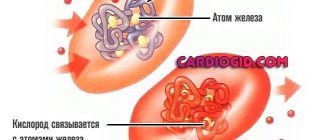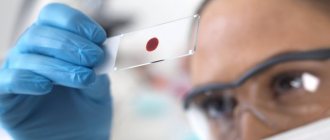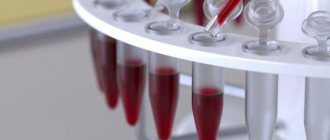What is creatinine?
Creatine is destroyed in the muscles, and the residual product is creatinine.
Creatine is synthesized in the kidneys, pancreas and liver; in human muscles it becomes creatine phosphate . When it disintegrates, the energy necessary for a person is released. Thanks to this energy, nerve and muscle cells can function normally. The amount of creatine in the blood is different for all people, it depends on the amount of muscle a person has, so women have the same numbers (less), and men have different numbers. The amount of creatinine in the blood does not depend on his lifestyle; it also does not change during the day. The body removes it using urine. But, if a person has something wrong with his kidneys, then the amount of creatinine increases. Therefore, in order to determine whether a person’s kidneys are functioning well, they are often asked to take a creatinine test.
MRI of the liver: is a blood test done before the study?
Magnetic resonance imaging of the liver with contrast is prescribed:
- if tumors and metastases are suspected;
- to assess the condition of hepatocytes (liver cells) when affected by cirrhosis and other pathological processes;
- to determine the nature of disorders caused by congenital anomalies of the organ;
- to identify areas of narrowing of the bile ducts.
On MRI scans with and without contrast, a single metastasis in the liver is visualized
The most important function of hepatocytes is the deactivation of substances that have entered the body from outside, for their subsequent excretion by the kidneys. In case of hepatic-renal failure, this process is disrupted, and therefore, after the procedure with contrast, the patient’s health condition may deteriorate. In such cases, it is recommended to do a blood test to find out the levels of creatinine, albumin, liver enzymes, residual nitrogen and urea. If there are significant deviations from the norm, MRI with contrast is not done.
Who is prescribed the analysis?
A blood test is done to find out the amount of creatinine in the blood. The doctor decides whether a person needs this study or not.
But usually a creatinine test is prescribed in the following cases:
- A thorough examination is necessary, because the patient decided to become a kidney donor.
- The doctor suspects that the person is developing kidney or muscle disease.
- The doctor must prescribe a special drug to the patient, and he needs to decide on the dosage.
- The specialist, based on the following symptoms, thinks that the patient has an increased concentration of creatinine in the blood: he has difficulty breathing, is bothered by aching pain in the lower back, a feeling of heaviness appears, the person complains of fatigue, and has a confused consciousness.
- There are all the symptoms of kidney dysfunction: the patient has problems sleeping, weakness, he gets tired quickly, eats poorly, he has swelling in the wrists and face, problems with urination (burning, intermittency), it has changed color, has become foamy, pain in the lumbar region etc.
What is computed tomography with contrast?
CT scan of the brain with contrast refers to a special examination technique using layer-by-layer scanning with X-ray radiation. Thanks to CT with contrast, it is possible to obtain the most accurate modeling of the internal structure of the body in three-dimensional space after filling the vessels with an intensifying substance. The doctor examines the condition of tissues, vessels, organs both separately and as a whole (after program reconstruction). The examination is more specific and informative when compared with radiography.
The use of the method makes it possible to track microcirculation and visualize soft tissues that are not visible during native scanning. To reduce the likelihood of complications after tomography, before the procedure, the doctor analyzes the outpatient card, studies tests, finds out whether there is an allergy to iodine, and excludes contraindications (diabetes mellitus, bronchial asthma).
Without a provocative test, a CT scan of the brain with contrast is dangerous for health, since the examination can provoke fatal conditions (anaphylactic shock, Quincke's edema).
Contrast is not used for myocardial infarction, liver failure, or kidney failure. Indications for the study are established for each patient individually to reduce the risk of complications.
Before contrast scanning, biochemical blood tests will be required for:
- ALT;
- Creatinine;
- Urea;
- AST.
After receiving the results, he plans the type and mode of examination - CT with a contrast agent or a native analogue.
Preparation
How to properly prepare if you are scheduled for a creatinine test? There are several points that must be observed:
- 2 days before the test, no physical activity, i.e. You will have to give up fitness, dancing, training, you can’t run or lift weights. Before going to the clinic, you should not quickly climb the stairs and somehow load yourself.
- In the evening, before taking a creatinine test, you should not have dinner with fatty foods, or at least you need to reduce the amount as much as possible. It is also undesirable to eat foods that contain a lot of protein. The day before the examination, you should not drink alcoholic beverages, abuse coffee or strong tea.
- Blood is taken for analysis on an empty stomach, which means that a person should not eat anything for at least 8 hours, but it is better if abstinence from food is longer (10-12 hours).
- In the morning before taking the test, you cannot drink tea or juice, as well as coffee, but you are allowed to drink some still water.
- If possible, you should also give up medications. You can talk about this separately with your doctor. You should also not take painkillers, which could cause the test to be false. These are phenacytin, aminopyrine, and some anti-inflammatory drugs.
- Before going for analysis, you should not smoke for 1-2 hours or at least 30 minutes.
- You should not worry at the time of donating blood; before doing so, you need to relax and sit quietly for at least a quarter of an hour.
Basic rules for preparing for an MRI examination
Initially, you will need to prepare all documents including data on the disease being studied or examination of the affected area (results of an ultrasound or x-ray examination, an extract from the medical history). Before starting the scan, it is advisable to empty the intestines in order to prevent the appearance of irritating factors during the MRI procedure and not to complicate the diagnosis.
How to properly prepare for certain types of MRI diagnostics? The following rules are required:
- MRI examination of the head, spinal cord, vascular system, heart, and various joints does not provide special preparatory work for men and women;
- To perform an MRI examination of the abdominal area and complete screening, the child must not eat for 6 hours before the start of the MRI scan. When an MRI test is done without anesthesia, you must first drink water (one to two glasses). Men and women suffering from granulomatous enteritis consume about 1.5 liters of mannitol solution 2 hours before an MRI examination. The product is provided by employees of the medical institution performing tomography;
- When undergoing an MRI scan using general anesthesia, on the day of the procedure (3 to 4 hours before) it is not allowed to fill the stomach with food or liquid. The requirement is mandatory; there is a risk of the mass located inside the gastrointestinal tract entering the respiratory canals. A threat to the life of the object under study cannot be ruled out;
- When checking the lower pelvic organs, the bladder must be kept moderately full. To reduce intestinal gas formation, drink activated charcoal;
- On the day of an MRI, women are not allowed to use mascara and eye shadow; cosmetics may include metal components that have the property of being magnetized to the installation; removing them is problematic;
- When performing diagnostics, children are given sedatives to suppress fear. It is useful to first make sure that there is no allergic reaction to the sedative.
Analysis result
If a test for creatinine shows that the concentration of this substance is increased, then this indicates that the person has some kind of disease related to kidney function, for example, urolithiasis, or pathology of the muscular system. But this is not always a sign of a disease; this result also happens in the following cases:
- The test was taken by an athlete who has a high level of muscle mass and, as a result, has more creatinine.
- Man has composed his menu in such a way that it is dominated by meat products, which contain a lot of protein.
- The patient was prescribed medications that resulted in changes in creatinine levels.
- The person was severely dehydrated at the time of the test.
If the creatinine level is low, then this indicates liver disease, or a decrease in muscle mass, which happens with prolonged fasting, there are other reasons. But this does not always indicate disorders in the body; a similar result can occur if a woman is pregnant (1st and 2nd trimester).
In any case, the test results should be assessed by a doctor who looks not only at the level of creatinine, but also at the general condition of the person, at the symptoms of certain diseases. If necessary, he will prescribe additional examinations to make a final diagnosis.
Analysis of creatinine and urea levels in the blood
What can the level of creatinine or urea in the blood tell a person? This question will be answered in this article. The article will also help you understand which indicators can be critical and in what cases.
Blood urea and creatinine levels
Everyone knows that in order to be healthy, you should lead a healthy lifestyle and also eat right. It is also necessary to undergo periodic examinations at the clinic, taking blood tests to identify indicators. One of these indicators is the level of creatinine and urea in the blood.
Since the body requires a lot of nutrients for normal functioning, it needs to get them from somewhere. Most of these components enter the body with food. Some of the components are absorbed by the body, and some are removed from the body by natural means. One of the substances found in the blood is called urea. If its level in the body is normal, then it is not harmful to the body, but when the level is elevated, it can cause certain complications. When performing such an analysis, a specialist can detect the amount of urea in the blood and determine how, for example, a person’s kidneys function.
Creatinine is also a natural product of the body, the amount of which can be determined if tested. It is known that the more protein a person eats, the higher the level of urea and creatinine will be in the blood when tested. It should also be noted that the numbers that indicate the level of these substances in the blood are not critical. Each person's indicators may be different. So, for example, an athlete who consumes a large amount of protein will have an increased level of creatinine in the body, but this will not be critical for him.
Creatinine can accumulate in the body more slowly than urea. If a person ate a lot of meat before taking the test, he will have an increased level of creatinine. But this does not mean that there are any problems with his health. If a person is diagnosed with kidney disease, then an increased level of creatinine during testing will indicate the need for treatment.
Based on the above, we can conclude that for a healthy person, urea and creatinine levels are not critical, even if they are overestimated. But if a person has some kind of disease, and these indicators are overestimated, then this should be the reason for his examination.
Blood tests for urea and creatinine
You can check the amount of urea in the blood using a biochemical analysis. Here, before taking the analysis, you should adhere to the following rules:
- Don't eat in the morning.
- Do not take medications the day before.
- Tell the doctor about the diseases that are present in the body at the time of the test.
It is also recommended not to take protein foods and avoid stress on the body a few days before submitting the material. After the analysis, urea levels are compared with the norm. If it is increased, then this may be an indicator of both the presence of a disease and poor nutrition. To check this, the doctor can prescribe a diet to his patient, and then ask him to take tests again. At this stage, he can find out the reasons for the increased level of urea in the blood.
Also, an increased level of urea or creatinine may indicate that a tumor has appeared in the body and is growing. Often such a growth can be in the urinary tract or intestines. This may also indicate the appearance of leukemia.
If there is a reduced amount of these elements in the blood, then this may also indicate a health problem, namely the liver. This could be cirrhosis or hepatitis, as well as other diseases.
But you shouldn’t panic in any case, since the level of these substances directly depends on how waste products break down in the body. This process can occur differently for each person. After taking the tests, it is important to undergo a more thorough examination and be observed by a doctor, who will make a final diagnosis.
Also, low levels of urea and creatinine can occur in women or children. This is due to the characteristics of their organisms. Elevated levels may occur in meat eaters, people with burns, or those who are sick.
(1 ratings, average: 5.00 out of 5)
testanaliz.ru










